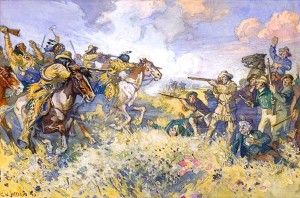- Causes
– political and technological changes increased poverty and hardships for families
-Hudson´s Bay Company extended their region into Northwest Company territory
-The fourth Earl of Selkirk wanted to settle three groups on his lands in British North America who would take lots of land
-Selkirk settlers are going hungry
-MacDonnell created the Pemmican Proclamation that does not allow people to sell pemmican outside the colony- makes buffalo running illegal
-NWC and Metis threaten and harass colonists (stole lifestock and tools, burn crops and houses
- Components
-NWC stole Pemmican from HBC
-NWC take over forts
-HBC sends Robert Semple to find the Pemmican thieves
-Semple (force of 21 men) meets Cuthbert Grant (Metis)- 65
-no one know who shot first
-Grant and the Metis win
-15 minute battle
- Consequences
-colonists leave
-Selkirk takes over NWC forts and arrests employees
-Metis now believe that the English had no regard for Metis way of life
-Britain now sees the Metis as savages who need to be civilized
-conflict with two economic systems- Metis will want the Buffalo hunt and the British want agriculture
The picture above shows the Battle of Seven Oaks, where Metis and the English for about fifteen minutes, at Seven Oaks, North of Winnipeg. All that resulted from a number of causes that mostly were connected to the competition between HBC and NWC. The first one of those reasons was that the Hudson´s Bay company ran out of beaver population so they extended their region into the NWC region, which was the first conflict. Also settlers in Selkirk were going hungry due to the Pemmican law and being not allowed to do buffalo running anymore. When the HBC sends Robert Semple to find the Pemmican thieves, he and his delegation, which includes 21 men, run into a group of Metis, which included 65 men and they started fighting. Nobody really knows who shot first, but we do know the battle only lasted for about 15 minutes, which was a very short battle compared to other fights on history. In the picture the Metis are charging at the English, so the picture definitely shows and supports the British perspective, since the British depicted the Metis as savages. The Metis won the battle, so there were some consequences for both the British and Metis. Their image of each other got supported, the Metis were convinced that the British did not have any regards of the Metis lifestyle. The British were even more convinced that the Metis were savages that they had to deal with and that had to be civilized. The battle also created a new conflict, this time it was an economic one: The British wanted an agricultural based economy, while the Metis wanted a Buffalo hunt based economy.


Good job. Might work better to have the analysis as it’s own paragraph.